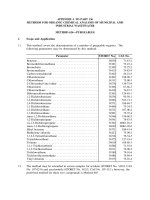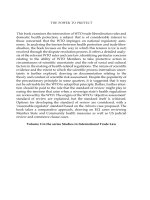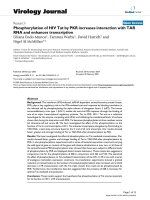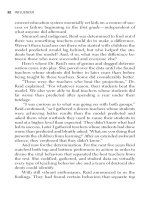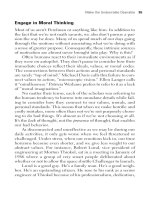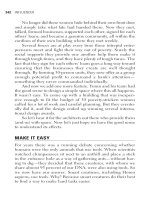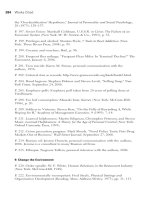Influencer The Power to Change Anything by Kerry Patterson, Joseph Grenny, David Maxfield and Ron McMillan_6 pot
Bạn đang xem bản rút gọn của tài liệu. Xem và tải ngay bản đầy đủ của tài liệu tại đây (766.26 KB, 21 trang )
Make the Undesirable Desirable 95
Engage in Moral Thinking
Most of us aren’t Perelman or anything like him. In addition to
the fact that we’re not math savants, we also don’t pursue a pas-
sion the way he does. Many of us spend much of our days going
through the motions without associating what we’re doing with
a sense of greater purpose. Consequently, these intrinsic sources
of motivation are almost never brought into play. Why is this?
Often humans react to their immediate environments as if
they were on autopilot. They don’t pause to consider how their
immediate choices reflect their ideals, values, or moral codes.
The connections between their actions and personal standards
are rarely “top of mind.” Michael Davis calls this failure to con-
nect values to action, “microscopic vision.” Ellen Langer calls
it “mindlessness.” Patricia Werhane prefers to refer to it as a lack
of “moral imagination.”
No matter their terms, each of the scholars was referring to
the human tendency to burrow into mundane details while fail-
ing to consider how they connect to our values, morals, and
personal standards. This means that when we make horrific and
costly mistakes, more often than not we’re not purposely choos-
ing to do bad things. It’s almost as if we’re not choosing at all.
It’s the lack of thought, not the presence of thought, that enables
our bad behavior.
As disconnected and unreflective as we may be during our
daily activities, it only gets worse when we feel threatened or
challenged. Under stress, when our emotions kick in, our time
horizons become even shorter, and we give less weight to our
abstract values. For instance, Robert Lund, vice president of
engineering at Morton Thiokol, sat in a meeting in January of
1986 where a group of very smart people deliberated about
whether or not to allow the space shuttle Challenger to launch.
Lund is a good guy. He’s a family man. He’s a good neigh-
bor. He’s an upstanding citizen. He rose to his rank as a senior
engineer at Thiokol because of his professionalism, dedication,
96 INFLUENCER
and attention to detail. Yet in the January meeting, Lund
behaved in a way that begs understanding. Days earlier Lund’s
engineering staff had warned him that no one knew how
O-rings would perform at very low temperatures. The previous
lowest launch temperature had been 54 degrees Fahrenheit.
Expectations were for a 26-degree launch. If the O-rings failed,
the consequences could be disastrous.
Now Lund is sitting in a launch meeting. NASA is asking
for hard data showing that O-rings would fail at the low tem-
perature. Lund has to make a decision. As he’s trying to decide
what to say—what stand to take—his supervisor says to him,
“Take off your engineering hat and put on your management
hat.” And that did it. Suddenly the moment transformed into
management decision making. No longer was it about protect-
ing lives. With a modest verbal shift, Lund’s feelings about what
he needed to do changed. Unproven O-ring risks were just a
management uncertainty—of which there are many. Saving
lives was no longer the top priority. Lund assented to the
launch. The rest is history.
Robert Lund moved from torturing over moral issues to
managing uncertainty as he buried himself in the details of the
risk analysis. When Lund needed to be at his best with his most
moral behavior, he was at his worst. And we all do it. When
facing the harsh demands of the moment, instead of acting on
our values and principles, we react to our emotions by short-
ening our vision and focusing on detail. We act against our own
values in a way that we ourselves would otherwise abhor. If only
we could step away from the moment and take a look at the
big picture.
So, here is the challenge influencers must master. They
must help individuals see their choices as moral quests or as per-
sonally defining moments, and they must keep this perspective
despite distractions and emotional stress.
To learn how to link people’s actions to their values—in gra-
cious and effective ways—we return to our reliable guide, Dr.
Make the Undesirable Desirable 97
Albert Bandura. Bandura has repeatedly looked at the question,
How can we stimulate people to connect their actions to their
values or beliefs? and has turned it on its head by asking, How
is it that people are able to maintain moral disengagement? That
is, how do people find ways to enact behaviors that appear so
clearly at odds with their espoused values?
Bandura’s research has uncovered four processes that allow
individuals to act in ways that are clearly disconnected from
their moral compass. These strategies that transform us into
amoral agents include moral justification, dehumanization,
minimizing, and displacing responsibility.
Let’s turn to a real-life case to see how these four processes
work in combination to keep people morally disengaged. When
Dennis Gioia, Ford recall director, looked at “graphic, detailed
photos of the remains of a burned out Ford Pinto in which sev-
eral people had died,” you would think he would have imme-
diately issued a recall of the car. And yet he didn’t. Data
showed that a 30-mile-per-hour rear-end collision would cause
the fuel tank to rupture, causing unspeakable injury or death
to the passengers. And now Gioia was staring at the devastat-
ing result. The good news was that a fix would cost a mere $11
per vehicle.
But Gioia didn’t issue a recall because he had been trained
to use cost-benefit analysis when reviewing equipment, and
that’s what he did. The Ford Motor Company set the value of
a human life at $200,000, so a simple calculation of the cost
of the recall revealed that the greatest dollar benefit would
come from keeping the vehicle cheap and settling inevitable
claims. Perhaps there would be a hundred or so such claims.
Gioia’s training established a moral framework that justified
what others would call manslaughter. And lest we judge him
too harshly, take note that we all do something similar every
day. When we accept lower prices rather than demand stiffer
pollution standards, we are, in essence, making life harder for
some number of individuals who have weak respiratory systems.
98 INFLUENCER
And yet we don’t think of the issue in those terms. Like Gioia,
who thought of claims, not lives, we think of costs, not health.
As Bandura suggested, we’re able to justify our behavior by
focusing on other moral outcomes—e.g., we’re making the
product affordable to the masses. In so doing, we dehumanize
those who may be affected by our choices. Then we attempt
to minimize and justify our actions. “It’s only 100 lives.
Compare that to the hundreds of thousands of people who will
benefit from this vehicle.” Finally, we displace responsibility:
“I didn’t set the rules for cost-benefit analysis. This is just the
way it’s done.”
The only way out of the nasty practice of disconnecting our-
selves from our moral grounding is to reconnect. This means
that we must take our eyes off the demands of the moment
and cast our view on the larger moral issues by reframing real-
ity in moral terms. And we have to do it in a way that is both
vibrant and compelling. Simple lectures, homilies, and guilt
trips—verbal persuasion at its worst—won’t work. If we don’t
reconnect possible behavior to the larger moral issues, we’ll
continue to allow the emotional demands of the moment to
drive our actions, and, in so doing, we’ll make short-term,
myopic choices.
Connect Behavior to Moral Values
When we inspect our actions from a moral perspective, we’re
able to see consequences and connections that otherwise
remain blocked from our view. Renowned psychologist Dr.
Stanton Peele reports that taking a broader moral perspective
enables humans to face and overcome some of their toughest
life challenges. In fact, Peele has been able to systematically
demonstrate that this ability to connect to broader values pre-
dicts better than any other variable who will be able to give up
addictive and long-lasting habits and who won’t. Peele has
found that individuals who learn how to reconnect their dis-
Make the Undesirable Desirable 99
tant but real values to their current behavior can overcome the
most addictive of habits—cocaine, heroine, pornography, gam-
bling, you name it.
At Delancey, Mimi Silbert follows Peele’s advice by help-
ing residents connect behaviors to values every single day. As
we suggest earlier, when residents first arrive at Delancey,
they’re told that everyone must challenge everyone. New resi-
dents view this action as “ratting out their buddy.” Ratting is
morally despicable. It’s disloyal. No decent person would do it.
So no one does it—certainly no one from their previous life.
Should a friend head out Delancey’s front gate in search of a
fix, residents’ old credo would tell them to be loyal and clam
up. And they’ll continue to act this way unless they can recast
the behavior of “ratting” into more positive moral terms. Then
residents will challenge every wrong action according to the
code.
Sure enough, Silbert helps them do just that. She reframes
the habit of reporting violations to the authorities as a vital
behavior, even a mission, that carries with it profoundly moral
meaning. She doesn’t merely hint at the morality of the code;
she fully embraces it. In her own words:
Our approach here is kind of an odd one. We talk morals
all the time. Although I studied criminology and psychol-
ogy, I approach these issues as if I have no idea what
causes criminal behavior. We just say, “This is our fam-
ily and this is our home. And in our home, here’s what
we believe. Here’s what we do. Here’s why. If you turn oth-
ers in, it helps them. We do it because we must help each
other if we want to succeed.” We develop a community
based on simple moral ideas and then make the norms
so strong that the community sustains them.
Silbert believes that if people can make their behavior part of
a broader and more important moral mission, they can do almost
anything, including giving up crime, drugs, and violence.
100 INFLUENCER
Listen to her argument. She’s working with a population
that walks in the gate with zero self-esteem, so she teaches
residents how to regain their sense of worth by connecting
to a broad moral mission. She explains, “I don’t like the word
self-esteem. Ultimately if you don’t earn your own self-respect,
you’ll tear yourself apart. No one else can give it to you. It
doesn’t come from sitting in a group and having someone say,
‘I feel very good about you.’ . . . You convince yourself over time
that you’re good, and it takes hard work.
“But you can’t do it alone. You don’t get it by someone
helping you. You get it by you helping someone else. It’s being
the helper that makes you like yourself. So will you confront
people who screw up? Yes, you will. Will you take responsibil-
ity for someone else’s problems? Yes, you will. And when you
do, you’ll respect yourself. Because you matter when you mat-
ter to someone else.”
So there you have it. Dr. Silbert connects behavior—
in this case behavior that is originally cast in ugly terms
(“ratting”)—to consequences, values, and an overall sense of
morality. Does it work? Can this kind of old-fashioned moral
motivation help residents reengage their sense of responsibil-
ity and self-control? Delancey has no guards, no locks, no
restraints. Just thousands of success stories.
Spotlight Human Consequences
Let’s see where we are. We’re trying to find a way to make good
behaviors intrinsically pleasurable and bad ones objection-
able. To do so, we’re looking at how to tap into people’s over-
all values and moral framework as a means of transforming
unpleasant behavior into pleasant activities.
Now let’s turn our attention to the other side of the coin.
People are doing bad things—let’s say they’re abusing other
people—but without feeling bad about themselves or what they
are doing. And when we say abuse, let’s define it in the broad-
Make the Undesirable Desirable 101
est sense. In addition to crimes against humanity, let’s include
ignoring the legitimate needs of a customer, eliminating jobs
with no consideration for the human toll, setting up another
department to fail, or parking in a handicapped spot for a quick
dash into the grocery store.
How can humans so easily disconnect their behavior from
the negative outcomes they’re causing? What can influence
masters do to help people connect their behavior to their
results and in so doing reconnect people to their espoused val-
ues of treating others with dignity and respect?
First, we must understand how people can abuse others
without feeling bad. The mechanism that allows people to act
viciously, but with impunity, is actually quite simple. When we
see less of the humanity of another person or when we disre-
spect people, it becomes easy for us to dismiss our actions
toward them. We’re nice to good people, but bad people, well,
they deserve whatever we give them.
Albert Bandura tested this proposition in a way that shows
just how insidious dehumanization can be. He asked, “Can a
one-word label that minimizes a victim’s humanity turn good
people into perpetrators?” Here is how the study worked.
Bandura told subjects that they’d be helping to train stu-
dents from a nearby college by shocking them when they
erred on a task. Their shock box had 10 levels of intensity that
they could deliver over 10 trials. Just as the study was about to
begin, the subjects were allowed to “overhear” an assistant talk-
ing to the experimenter. The assistant uttered one of three
phrases:
Neutral: “The subjects from the other school are here.”
Humanizing: “The subjects from the other school are here.
They seem nice.”
Dehumanizing: “The subjects from the other school are
here. They seem like animals.”
102 INFLUENCER
From this point on Bandura did not pressure subjects to use
the shock box. The decision was completely up to them. And
here’s what Bandura found: The subjects who imagined their
victims seemed like animals shocked them at increasing levels
over each trial, giving them significantly more punishment
than those who had heard the neutral phrase. The subjects who
had heard the humanizing phrase shocked their victims at sig-
nificantly lower levels.
The one-word label was enough to cause good people to
become perpetrators.
Dr. Don Berwick, head of IHI’s 100,000 Lives Campaign,
identifies still another way we routinely dehumanize people
and their circumstances by transforming them from people into
cold, hard data. In this case, Berwick explains how safety prob-
lems can be unwittingly minimized by some health-care exec-
utives as they dehumanize the problem.
“Executives aren’t ignoble, but they can become insu-
lated—a little out of touch.” And it’s no wonder. These exec-
utives are routinely overwhelmed with streams of data that
demand immediate responses. Information overload plays a
role in this problem, but more important is the abstract qual-
ity of the information that transforms human disaster into facts
and figures.
Most executives get their information in the form of cold
numbers that don’t carry much emotional weight. “Abstraction
poisons the type of energy I need,” Berwick continues to explain.
“When raw personal trauma is boiled down into the same kind
of spreadsheet or graph used to track laundry, too much of its
essence is lost. When an executive sees a number in a spread-
sheet, not a patient with a gaping wound, it’s easy to imagine
the negative outcome isn’t quite as bad as it really is.”
As a result of this dehumanization, executives can easily
view patient safety data with detachment. Instead of giving
them special treatment or priority, the executive considers
them alongside every other spreadsheet number on the desk.
Make the Undesirable Desirable 103
The way Berwick helps executives reconnect to the human
elements of every safety problem is by creating powerful vicar-
ious and direct experiences. As we explained earlier, Berwick
relies on stories and significant emotional events to increase his
ability to create change. Were he to use the much-abused tool
of verbal persuasion, particularly facts and figures, he’d lose both
credibility and power. Ironically, when you want an individual
disaster—one with a name and a face—to seem even more
important, you’re tempted to bundle it with dozens of other indi-
vidual disasters into a one-lump “impressive” number. In so
doing, you drop the names, the faces, and the humanity; even-
tually you also drop your ability to exert influence.
Dr. Berwick never makes this mistake. Instead he helps hos-
pital CEOs create vicarious experiences by asking them to,
“Find an injured patient in your system and investigate the
injury. Don’t delegate it. Do it yourself. Then return and share
your story.” The CEOs Berwick is working with already know
the statistics about hospital injuries and accidental deaths. But
what makes them “zealots for quality improvement” from that
experience forward is the dramatic experience they have first-
hand with human consequences. They can no longer remain
morally disengaged through the use of dehumanizing statistics
because they now know a name.
Now for a corporate application. If you’re a leader attempt-
ing to break down silos, encourage collaboration, and engage
teamwork across your organization, take note. Moral dis-
engagement always accompanies political, combative, and
self-centered behavior. You’ll see this kind of routine moral
disengagement in the form of narrow labels (“bean counters,”
“gear heads,” “corporate,” “the field,” “them,” and “they”)
used to dehumanize other individuals or groups. To reengage
people morally—and to rehumanize targets that people read-
ily and easily abuse—drop labels and substitute names.
Confront self-serving and judgmental descriptions of other
people and groups. Finally, demonstrate by example the
104 INFLUENCER
need to refer to individuals by name and with respect for their
needs.
Win Hearts by Honoring Choice
Let’s get tactical for a minute. As you do your best to help oth-
ers take more pleasure from healthy activities and less pleas-
ure from unhealthy activities, you’ll need to choose your tactics
carefully. When you attempt to help others reconnect their
behaviors to their long-term values or moral anchors, you often
come off as preachy or controlling and generate a great deal of
resistance. Of course, the more you try to control others, the
less control you gain. This is particularly true with individuals
who are addicted to their wrong behavior. They have already
suffered through the impassioned speeches of their loved ones,
listened to the clever audio CDs from the experts, and
squirmed in their pew as their minister has harangued them for
their self- and other-defeating actions.
Nevertheless, these offenders have been able to withstand
the shrill cry to return to the right path because they aren’t acci-
dentally disengaged from their moral compass; they’re purpose-
fully disengaged. The lack of a connection between their
actions and their values is so obvious and the resultant disso-
nance so painful that they openly and aggressively resist any-
one who has the nerve to shine a light on the humiliating
discrepancy. Verbal persuasion and other control techniques
aren’t going to work with these folks.
William Miller is the influence expert who has found a way
to help addicts connect to their moral compass and thus greatly
improve their life habits. He started his impressive research by
asking the simple question, “What’s better—more therapy or
less?” and found that the length of time therapy lasted was irrel-
evant. This finding, of course, made him extremely unpopu-
lar with the vast majority of people who worked in the field.
Next he asked, “Is there one therapeutic technique that works
Make the Undesirable Desirable 105
better than others?” and found that the method didn’t matter
much either.
After offending almost everyone in his field by undermin-
ing the apparently irrelevant distinctions upon which people
build careers, he stumbled onto an interesting finding. He
found a distinction that did matter. It had to do less with what
the counselor did than with what the counselor didn’t do.
A reigning but inaccurate assumption in counseling is that
confrontation motivates change. But despite all the hoopla
about family interventions and counselor-led confrontations,
Miller learned that forcing people to face their demons along
with their friends, colleagues, and therapists who hated those
demons also didn’t work. In fact, in one study, he found that
confrontation actually increased alcoholic binging. This led
Miller in a different direction. He began to explore the oppo-
site. What if the counselor merely helped patients figure out
what they wanted rather than what their fed-up friends wanted?
With the new question, Miller discovered that the best way
to help individuals reconnect their existing unhealthy behav-
iors to their long-term values was to stop trying to control their
thoughts and behaviors. You must replace judgment with
empathy, and lectures with questions. If you do so, you gain
influence. The instant you stop trying to impose your agenda
on others, you eliminate the fight for control. You sidestep irrel-
evant battles over whose view of the world is correct.
This discovery led Miller to develop an influence method
called motivational interviewing. Through a skillful use of open
and nondirective questions, the counselor helps others examine
what is most important to them and what changes in their life
might be required in order for them to live according to their val-
ues. When you listen and they talk, they discover on their own
what they must do. Then they make the necessary changes.
Dozens of studies have shown Miller’s approach to be
effective in helping people overcome alcoholism, smoking,
drug addiction, HIV risk behaviors, and diet failures, and to
106 INFLUENCER
improve things like psychiatric treatment adherence and exer-
cise commitments. And the additional good news is that the
power of motivational interviewing isn’t limited to therapeutic
settings. Smart leaders accomplish the same results when they
replace dictates with dialogue.
For example, Ralph Heath, now president of Lockheed
Martin Aeronautics, was tasked by the company to move the
fifth generation F-22 fighter jet from drawing board to produc-
tion floor in 18 months. To do so, he had to engage 4,500 engi-
neers and technicians who had developed a decade-long
culture of invention. Heath had to convince them that results
mattered more than ideas and that engineering needed to bow
to production. Tough sell.
So Heath didn’t sell; he listened. He spent weeks inter-
viewing employees at all levels. He tried to understand their
needs, frustrations, and aspirations. When he finally began issu-
ing orders, he framed them in ways that honored the needs,
concerns, and goals of his colleagues. His influence didn’t
result from merely confronting problems, but from listening to
people.
What William Miller teaches us is that a change of heart
can’t be imposed; it can only be chosen. People are capable of
making enormous sacrifices when their actions are anchored
in their own values. On the other hand, they’ll resist compul-
sion on pain of death. The difference between sacrifice and
punishment is not the amount of pain but the amount of
choice.
Ginger Graham, the CEO of the medical devices company
Guidant, learned this in a crisis. After the company introduced
a new cardiovascular stent, sales went through the roof.
Graham wrote of this in her April 2002 article for the Harvard
Business Review titled, “If You Want Honesty, Break Some
Rules.” Almost overnight, demand for the stent far outstretched
supply. And all this hit as the holidays were approaching.
Executives figured that just meeting demand until new sources
Make the Undesirable Desirable 107
of production could come online would require three full shifts
and seven-day weeks. Graham could have simply mandated the
work and required people to fill their obligations. But she knew
that wouldn’t work. Not only was it unfair to the employees to
force this on them when they deserved time off, but it would
also provoke resentment and hurt productivity.
So instead, Graham asked. At an all-company meeting, she
praised the work that had brought about the wonderful success.
She shared the sales data. She read success stories from doc-
tors who were using the stent to avoid bypass surgery and save
patients’ lives. She extrapolated the sales data and showed how
many unmet needs would result if supply couldn’t be stepped
up substantially. And then she made a request: “We have the
chance to do something [for patients and for ourselves] that no
company has ever done in the history of our industry. We have
an obligation to rise to the challenge. And if you’ll rise to the
challenge, we’ll do all we can to make your lives easier during
the tough times.”
Within half an hour, employees had made a list of all the
things management could do to help them through the holi-
days—including shop for their presents, wrap them, supply late-
night taxis, bring in pizza, and so on. And with that, employees
made a pact with management. Production hit new records,
and the product was available on time for all patients who
needed it. Total sales almost tripled in one quarter. Employees
earned nice bonuses. But more importantly, all those who went
through this experience felt they were part of something spe-
cial. Something important. A moral quest. All because they
were allowed to choose.
What Miller, Heath, and Graham learned is that you can
influence even a resistant group of people if you’re willing to
surrender control. When you surrender control, you win the
possibility of influencing even addictive and highly entrenched
behaviors. And you gain access to one of the most powerful
human motivations—the power of a committed heart.
108 INFLUENCER
SUMMARY: INTRINSIC SATISFACTION
Helping people extract intrinsic satisfaction from the right
behavior or feel displeasure with the wrong behavior often calls
for several influence strategies. With individuals who believe
that the required behaviors won’t be pleasurable, simply
immerse them in the activity. With our out-of-shape and over-
weight friend Henry, for example, he’ll learn to like certain
healthier foods and take pleasure in certain means of exercise
only when he gives them a fair chance.
As you experiment with new actions, focus on the sense of
accomplishment associated with the result. Revel in achieving
for the sake of achieving. Tap into people’s sense of pride and
competition. And when it comes to long-term achievement,
link into people’s view of who they want to be. For instance,
Henry sees himself as a healthy and fit person—despite his cur-
rent condition—and needs to stop and consider the pleasure
associated with his new healthy behaviors as well as celebrate
new levels of accomplishment.
When dealing with activities that are rarely satisfying or
unhealthy activities that are very satisfying, take the focus off
the activity itself and reconnect the vital behavior to the per-
son’s sense of values. Don’t be afraid to talk openly about the
long-term values individuals are currently either supporting or
violating.
For instance, during the first few weeks of his exercise reg-
imen, Henry may need to focus on his value of living a fit life,
not on the discomfort he’s experiencing. Later, as exercising
becomes less painful, even enjoyable, he’ll be able to take sat-
isfaction from enacting the vital behaviors themselves.
As people slip further into inappropriate behavior—even
causing severe damage to themselves or others—help them
reconnect their actions to their sense of morality by fighting
moral disengagement. Don’t let people minimize or justify
their behavior by transforming humans into statistics.
Make the Undesirable Desirable 109
Finally, when facing highly resistant people, don’t try to
gain control over them by wowing them with logic and argu-
ment. Instead, talk with them about what they want. Allow
them to discover on their own the links between their current
behavior and what they really want.
In short, as you think about the problems you’re trying to
resolve, don’t be afraid to draw on the power of intrinsic satis-
fiers. As Don Berwick so aptly stated: “The biggest motivators
of excellence are intrinsic. They have to do with people’s
accountability to themselves. It’s wanting to do well, to be
proud, to go home happy having accomplished something.”
Berwick recognizes that people have a powerful desire to do
what’s right. Harnessing that intrinsic desire is a far more pow-
erful influence tool than using extrinsic rewards or exacting
punishments.
This page intentionally left blank
111
5
Surpass Your Limits
PERSONAL ABILITY
It’s a funny thing, the more I practice the luckier I get.
—Arnold Palmer
Design
Rewards and
Demand
Accountability
Change the
Environment
Harness
Peer Pressure
Find Strength
in Numbers
Make the
Undesirable
Desirable
Surpass
Your Limits
MOTIVATION
PERSONAL
SOCIAL
STRUCTURAL
ABILITY
Copyright © 2008 by VitalSmarts, LLC. Click here for terms of use.
112 INFLUENCER
I
n Chapter 4 we examined ways to tap into personal passions
as a way of influencing vital behaviors. To that we add that
we can limit our success when we assume that any influ-
ence failure is exclusively a motivation problem. We commit
what psychologist Lee Ross calls the fundamental attribution
error.” We assume that when people don’t change, it’s simply
because they don’t want to change. In making this simplistic
assumption, we lose an enormous lever for change.
Even when we do realize that people may lack the ability
required to enact a vital behavior, we often underestimate the
need to learn and actually practice that behavior. Corporate
leaders make this mistake when they send employees to an
intensive day of leadership training that consists of flipping
through a binder or listening to engaging stories—but not actu-
ally trying any of the skills being taught. Participants mistakenly
assume that knowing the leadership content and doing it are
one and the same. Of course, they aren’t the same at all, so par-
ticipants usually return to the office and apply only a fraction
of what they studied.
When leaders and training designers combine too much
motivation with too few opportunities to improve ability, they
don’t produce change; they create resentment and depression.
Influence masters take the opposite tack. They overinvest in
strategies that help increase ability. They avoid trying to solve
ability problems with stronger motivational techniques.
To see how easy it is to confuse motivation and ability prob-
lems, let’s return to Henry—our friend who is trying to lose
weight.
THERE’S HOPE FOR EVERYONE
One of Henry’s vital behaviors—snacking on mini carrots
rather than chocolate—is at risk. At this very moment, Henry
is pulling the foil back on a partially eaten, two-pound choco-
late bar. In Henry’s defense, he didn’t buy it. A colleague who
Surpass Your Limits 113
knew of his deep affection for chocolate gave it to him. The
tempting bar sat on his desk for over a week.
Moments ago Henry decided to heft the plank-sized con-
fection merely to see what two pounds felt like. When he did,
he noticed that the adhesive holding the wrapper around the
inner foil lining had failed. It appeared as if it was about to fall
away, seductively revealing the beautiful red, shiny foil be-
neath it—the last defense before the chocolate itself.
Henry tugged at the wrapper playfully, and with almost no
effort it came free. The next few seconds were almost a blur.
Without thinking, Henry’s hands peeled back the top flap of
the foil and exposed the rich chocolate. In a rush, chocolate-
filled childhood memories poured through his head as his fin-
gers pried loose a single dark brown section—a modest,
harmlessly small packet of pleasure. He brought the treat to his
lips—and then it was over. The chocolate began its inexorable
transformation from cocoa, fat, and sugar to cellulite.
Here’s the problem. At the moment when Henry should be
enjoying one of his secret pleasures, he’s depressed. As he now
gobbles down the chocolate, with each bite he’s convinced that
he strayed from his diet because he lacks the proper strength
of character. It’s clear that he doesn’t have moxie or willpower.
In short, he’s a weak person. Up until this sad indulgence, he
had valiantly cut back on calories while sincerely promising
himself to start an exercise regime. This new, iron-willed Henry
ruled for eight full days. And then the mere touch of the red
foil lining brought him to ruin.
Henry wonders if he can overcome the genetic hand that
he’s been dealt. He has neither self-discipline to diet nor the
athletic prowess to exercise effectively. Surely he’s doomed to
a life of huffing and puffing. But then again, unbeknownst to
Henry, a long line of research suggests that maybe he isn’t
doomed at all. There’s a good chance that he can actually learn
what it takes to withstand the temptations of chocolate as well
as how to improve his ability to exercise properly.
114 INFLUENCER
In fact, many of the stories Henry has been carrying in his
head since he was a young man may be equally wrong. When
his mother once told him that he wasn’t exactly a gifted speaker
and later when his father suggested that leadership “wasn’t his
thing,” Henry believed that he hadn’t been born with “the right
stuff.” He wasn’t born to be an elite athlete; that’s for certain.
Later he learned that music wasn’t his thing, and his interper-
sonal skills weren’t all that strong. Later still he discovered that
spending in excess, getting hooked on video games, and gorg-
ing on Swiss chocolate were his thing. But none of this is going
to change because Henry, like all humans, can’t fight genetics.
Fortunately, Henry is dead wrong. Henry is trapped in what
Carol Dweck, a researcher at Stanford, calls a “fixed mindset.”
If he believes he can’t improve, then he won’t even try, and
he’ll create a self-fulfilling prophecy. But Henry is in luck.
Genes don’t play the fatalistic role scholars once assumed they
played in determining physical prowess, mental agility, and yes,
even self-discipline. Characteristics that had long been de-
scribed by scholars and philosophers alike as genetic gifts or
lifelong personality traits appear to be learned, much the same
way one learns to walk, talk, or whistle. That means that Henry
doesn’t need to accept his current status. He can adopt what
Dweck refers to as a “growth mindset.” Henry simply needs to
learn how to develop a set of high-level learning skills and tech-
niques that influence masters use all the time. He needs to
learn how to learn. Henry, like most of us, was actually born
with the right stuff; he just hasn’t figured out how to get it to
work for him yet.
To illustrate, let’s consider the lengthy hunt researchers
conducted in a quest to find the all-important trait of self-
discipline. Here was a personality trait worth studying. If the
ability to withstand the alluring smell of chocolate or the siren
call of buying shiny new products before you have the cash to
pay for them—the ability to delay gratification—isn’t a reflec-
tion of one’s underlying character, then what is?
Surpass Your Limits 115
Professor Walter Mischel of Stanford University, curious
about people’s inability to withstand temptations, set out to
explore this issue. Did certain humans have the right stuff while
others didn’t? And if so, did the right stuff affect lifelong per-
formance? What Mischel eventually came to understand
altered the psychological landscape forever.
MUCH OF WILL IS SKILL
When “Timmy,” age four, sat down at the gray metal table in
an experimental room in the basement of Stanford’s psychol-
ogy department, the child saw something that caught his inter-
est. On the table was a marshmallow—the kind Timmy’s mom
put into his cup of hot chocolate. Timmy really wanted to eat
the marshmallow.
The kindly man who brought Timmy into the room told
him that he had two options. The man was going to step out
for a moment. If Timmy wanted to eat the marshmallow, he
could eat away. But if Timmy chose to wait a few minutes until
the man returned, then Timmy could eat two marshmallows.
Then the man exited. Timmy stared at the tempting sugar
treat, squirmed in his chair, kicked his feet, and in general tried
to exercise self-control. If he could wait, he’d get two marshmal-
lows! But the temptation proved too strong for little Timmy, so
he finally reached across the table, grabbed the marshmallow,
looked around nervously, and then shoved the spongy treat in
his mouth. Apparently Timmy and Henry are kindred spirits.
Actually, Timmy was one of dozens of subjects Dr. Mischel
and his colleagues studied for more than four decades. Mischel
was interested in learning what percentage of his young sub-
jects could delay gratification and what impact, if any, this char-
acter trait would have on their adult lives. Mischel’s hypothesis
was that children who were able to demonstrate self-control at
a young age would enjoy greater success later in life because
of that trait.
